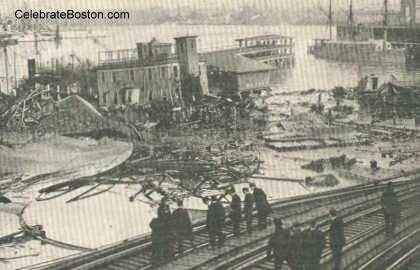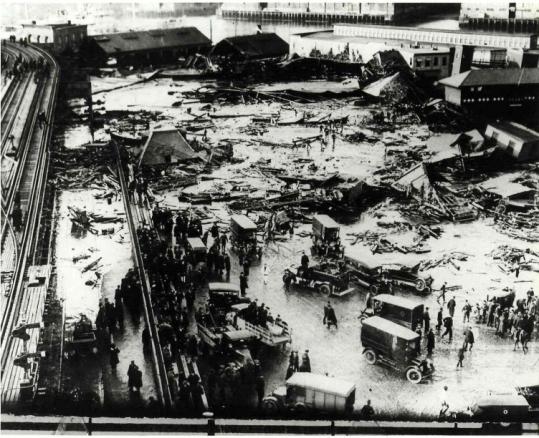

Wreckage under the elevated where many express trucks parked before the molasses flood. While outside, the wall of goo trapped some unlucky victims, hurled some into the air, flung some against freight cars and smothered still others. Inside the Boston and Worcester freight terminal, the river of molasses poured through the doors and windows.

He passed out, then opened his eyes to find three of his four sisters staring at him. He heard his mother call his name and couldn’t answer, his throat was so clogged with the smothering goo. Then he grounded and the molasses rolled him like a pebble as the wave diminished. According to a 1983 article in Smithsonian,Īnthony di Stasio, walking homeward with his sisters from the Michelangelo School, was picked up by the wave and carried, tumbling on its crest, almost as though he were surfing. The molasses surge picked up a truck and threw it into Boston Harbor.Ī small boy named Anthony di Stasio got caught in the molasses flood. It then tipped over a rail car and knocked buildings off their foundations.

The deadly ooze damaged the Boston Elevated Railway on Atlantic Avenue. The ground shook, and witnesses said the rivets popping out of the tank sounded like machine gun fire. Shortly after noon, the tank collapsed with a thunderous roar. The tank, though only a few years old, seemed shaky. People who lived and worked in the North End said the tank shuddered and groaned when the company filled it. The tank, 50 feet high and 90 feet in diameter, contained 2.3 million gallons of molasses originally destined for use in a munitions plant. Photo courtesy Boston Public Library, Leslie Jones Collection. Follow him on Twitter at on his brand new Facebook page.The Boston elevated twisted into new shapes after the molasses flood. He’s at work on a book about Los Angeles, A Los Angeles Primer. How the Titanic Sank: James Cameron’s New CGI AnimationĬolin Marshall hosts and produces Notebook on Cities and Culture and writes essays on cities, Asia, film, literature, and aesthetics. The Titanic: Rare Footage Before Disaster Strikes All these well-documented facts aside, legend has it that, on a particularly hot day on Commercial Street, you can still smell the stuff. For the most definitive study of this gooey calamity, you’ll want to seek out Dark Tide: The Great Boston Molasses Flood of 1919 by Stephen Puleo, who speaks in some detail about the event and its aftermath in this Real History video. The contemporary images above and below come from the Boston Public Library’s Flickr set. The tank’s “absurdly shoddy construction work,” led by a man who “couldn’t even read a blueprint,” came down to this: they “threw up a gigantic tank as quickly and cheaply as possible, skimped on inspections and safety tests, and hoped for the best.” You can learn more about what happened in the video above, a dramatization of the events leading up to the Great Molasses Flood from the pilot episode of The Folklorist. The United States Industrial Alcohol Company, owners of the brown, sticky substance in question and the exploding tank that contained it, pinned it on bomb-chuckers, claiming that, “since its alcohol was an ingredient in government munitions, anarchists must have sabotaged the tank.” Investigations later revealed the cause as none other than seat-of-the-pants capitalistic hubris, another standby of early 20th-century America. Those figures come from a post on the subject at Mental Floss, which investigates what loosed the Great Molasses Flood in the first place. It fits perfectly into early 20th-century American lore, this all-too-real disaster: on January 15, 1919, a fifteen-foot wall of molasses rushed through Boston’s North End, killing 21, injuring 150, doing $100 million in today’s dollars worth of damage, and requiring 80,000 man-hours to clean up.


 0 kommentar(er)
0 kommentar(er)
